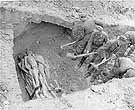
|
|
|

|

|

|

|
|
Click on an image to see a larger, more detailed picture.
|
|
|
|
|
| 1945: Liberation and Rebuilding |

|
pg. 613 |

|
|
|
|
| |
 The Allies often forced captured German soldiers to exhume victims of the Holocaust so that their corpses could be buried under more sanitary conditions. Here, several German POWs unearth a mass grave at Kaufering III. The Kaufering camps, 11 in all, were subsidiaries of the Dachau, Germany, camp. The Nazis intended for prisoners to build fighter-aircraft factories, a program that never developed. Thousands of Kaufering inmates died from disease, overwork, malnutrition, or execution, and their bodies were dumped like garbage.
The Allies often forced captured German soldiers to exhume victims of the Holocaust so that their corpses could be buried under more sanitary conditions. Here, several German POWs unearth a mass grave at Kaufering III. The Kaufering camps, 11 in all, were subsidiaries of the Dachau, Germany, camp. The Nazis intended for prisoners to build fighter-aircraft factories, a program that never developed. Thousands of Kaufering inmates died from disease, overwork, malnutrition, or execution, and their bodies were dumped like garbage.
Photo: National Archives/United States Holocaust Memorial Museum Photo Archive
|
 Anton Mussert (with hat) was the leader of the Nationaal-Socialistische Beweging der Nederlanden (Dutch Nazi Party). Although a firm supporter of the Nazis, he had very little influence over events during the long years of occupation. Hitler had no respect for him. On May 7, 1945, he was arrested by the Dutch Resistance. Mussert was executed exactly one year later.
Anton Mussert (with hat) was the leader of the Nationaal-Socialistische Beweging der Nederlanden (Dutch Nazi Party). Although a firm supporter of the Nazis, he had very little influence over events during the long years of occupation. Hitler had no respect for him. On May 7, 1945, he was arrested by the Dutch Resistance. Mussert was executed exactly one year later.
Photo: Verzetsmuseum Amsterdam / United States Holocaust Memorial Museum Photo Archive
|
 On April 29, 1945, Hitler chose Admiral Karl Dönitz (pictured) as his successor, naming him president and supreme commander of what remained of Germany's armed forces. The Führer was convinced that the SS, the Wehrmacht, and the Luftwaffe had betrayed him. Only the German Navy, which had long ceased to be a factor in the war, seemed to Hitler to be untainted. Further, Heinrich Himmler and Hermann Göring had broken with the regime and attempted to strike separate deals with the Allies in futile attempts to save their skins. So Dönitz succeeded Hitler mainly by default. During the 23 days that President Dönitz led Germany, he perpetuated Hitler's anti-Soviet policies. Found guilty at Nuremberg on counts of waging aggressive war and war crimes, Dönitz was sentenced to ten years' imprisonment.
On April 29, 1945, Hitler chose Admiral Karl Dönitz (pictured) as his successor, naming him president and supreme commander of what remained of Germany's armed forces. The Führer was convinced that the SS, the Wehrmacht, and the Luftwaffe had betrayed him. Only the German Navy, which had long ceased to be a factor in the war, seemed to Hitler to be untainted. Further, Heinrich Himmler and Hermann Göring had broken with the regime and attempted to strike separate deals with the Allies in futile attempts to save their skins. So Dönitz succeeded Hitler mainly by default. During the 23 days that President Dönitz led Germany, he perpetuated Hitler's anti-Soviet policies. Found guilty at Nuremberg on counts of waging aggressive war and war crimes, Dönitz was sentenced to ten years' imprisonment.
Photo: SYddeutscher Verlag Bilderdienst
|
|

|

|

|

|
 April 29, 1945: While trapped with intimates in his bunker beneath Berlin, Hitler dictates his final political testament. The document blames the Jews and their "collaborators" for the war and all of Germany's problems. Hitler ends by warning Germany: "Above all, I charge the leaders of the nation and those under them to scrupulous observance of the laws of race and to merciless opposition to the universal poisoner of all peoples, international Jewry."
April 29, 1945: While trapped with intimates in his bunker beneath Berlin, Hitler dictates his final political testament. The document blames the Jews and their "collaborators" for the war and all of Germany's problems. Hitler ends by warning Germany: "Above all, I charge the leaders of the nation and those under them to scrupulous observance of the laws of race and to merciless opposition to the universal poisoner of all peoples, international Jewry."
|
 April 29, 1945: Via a Radio Stockholm broadcast, Hitler learns of the April 28 execution of Italian dictator Benito Mussolini.
April 29, 1945: Via a Radio Stockholm broadcast, Hitler learns of the April 28 execution of Italian dictator Benito Mussolini.
|
 April 29, 1945: Mussolini's corpse, and that of his mistress, Clara Petacci, are strung upside down in Milan's Piazza Loreto and mutilated by an angry mob.
April 29, 1945: Mussolini's corpse, and that of his mistress, Clara Petacci, are strung upside down in Milan's Piazza Loreto and mutilated by an angry mob.
|
 April 29, 1945: The U.S. 42nd and 45th Infantry Divisions liberate the concentration camp at Dachau, Germany, and find 32,000 living inmates and 50 railroad cars piled with emaciated corpses.
April 29, 1945: The U.S. 42nd and 45th Infantry Divisions liberate the concentration camp at Dachau, Germany, and find 32,000 living inmates and 50 railroad cars piled with emaciated corpses.
|
 April 29, 1945: At Allach, Germany, near Munich, many Jewish refugees die of overeating following the arrival of supplies brought by American troops.
April 29, 1945: At Allach, Germany, near Munich, many Jewish refugees die of overeating following the arrival of supplies brought by American troops.
|
|
|
|
|
| 1945: Liberation and Rebuilding |

|
pg. 613 |

|
|
The Holocaust Chronicle
© 2009 Publications International, Ltd.
|
|
